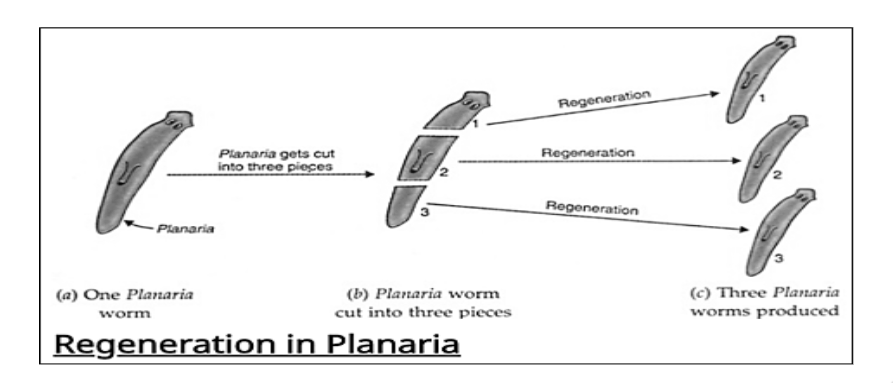Regeneration in planaria depends on the presence of stem cells called neoblasts. These planarian cells are uniformly distributed throughout the whole body. When any part of the worm is dissected, they are activated to reform the tissues that have been removed from the animal. It is still not clear how the stem cells regenerate into specific organs. However, in the regeneration in planaria, the pharynx part does not contain any stem cells and cannot regenerate the rest of the worm. But a worm deprived of the pharynx can readily regenerate this complex organ. Planarians are known as the members of the Platyhelminthes (flatworms). These animals have evolved a unique but remarkable stem cell system. An adult single stem cell type can give rise to an entire cell system and organs in planaria, thus completing regeneration in planaria.
Planarian Regeneration
When a planarian is cut into several pieces, each part of the dissected planaria grows into a complete organism. The process of regeneration in planaria is done by increasing the development of specialized cells and then differentiating to various cells and tissue types. We should know that regeneration and reproduction do not share the same meaning; a majority of the organisms we know would not normally depend on being cut up to several pieces and be able to reproduce from these dissected pieces. Thus, regeneration does not produce new offspring, whereas there is always a new offspring from their parent individual in reproduction.
Planarians exhibit so much extraordinary ability to regenerate planaria that are split lengthwise or crosswise will always regenerate into two same individuals. The function of ocelli (two eyes possessed by some planarians) is to detect light intensity, while others consist of several eyespots. The eyes spot acts as photoreceptors, which are used to move away from light sources.
Though the planaria itself does not have to be dissected in several pieces to witness the regeneration in planaria, only if the head of the planarian is cut in half down its center, and each side still attached to the planarian body, it is still possible for the worm to generate two heads and continue to live in that way.
Key to Regeneration
Another known form of asexual reproduction is regeneration. The ability of a simple organism to regrow its lost pieces by growing the same tissues and forming into a complete organism. In regeneration in planaria diagrams, we can see that complete adult planaria have been dissected. The dissected pieces grow their similar tissues and organs as the adult planaria, thus growing into a complete organism. The regeneration in planaria is unparalleled among the other simple organisms. If any adult worm is cut apart, almost any piece of that worm can fully be grown into a fully -functional animal with every organ (brain, kidney, nervous system, digestive system, muscles, and skin). The approximate time needed for this regeneration is just two weeks.
That’s why scientists consider them the ideal organism to study regeneration. But the phenomenon of this complete process of regeneration is still poorly understood in science. By the new report from the researchers, we came to know how the flatworms develop as an embryo in the process of regeneration and provide new intuition into this animal’s unique regenerative abilities. The first work shows that stem cells are the key to regeneration in planaria.
Asexual Reproduction in Planaria
Flatworms are also known in the group of freshwater planarians worldwide. Though by the process of fission, the planarian can reproduce asexually by just cutting themselves into two pieces – a head and a tail where both these parts grow onto two new fully -functional adult flatworms within an approximate time of just a week (as seen in regeneration in planaria diagram). However, this full regeneration mechanism in flatworms is still a puzzle for centuries due to the complex study and process of fission.
Fig: Regeneration in planaria diagram
The study of planarians is notoriously difficult. During fission, the flatworms do not like to be watched; this entire process of fission tends to happen in the dark and gets affected by the slightest disruption. Because this is not a frequent phenomenon – it approximately happens once every month for certain species. To capture the regeneration in planaria, continuous recording of videos is required to study the regeneration in detail.
Conclusion
The life history of the flatworms tends to make them a model to investigate several various biological processes, among those many of which may have inference for human health and diseases. The advanced way in molecular genetics technologies has made this gene study possible, and scientists can study them worldwide. Like ours planarians have a number of similar kinds of cell types and other inter-body features, which are homologous to our own cells and body organs. The simple study of regeneration in planaria facilitates more experimental studies. Foraging research, planarians are also known as an apparent model organism. These animals possess limitless regenerative abilities. In many parts of the world, flatworms are common, living in saltwater and freshwater (ponds, rivers, etc.). They are also terrestrial, mainly found under logs or in soil plants.
 Profile
Profile Settings
Settings Refer your friends
Refer your friends Sign out
Sign out





